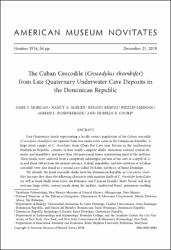/admin/item?itemID=d1032a50-7eec-4ea6-a667-e67d1fe65369
The Cuban crocodile (Crocodylus rhombifer) from late Quaternary underwater cave deposits in the Dominican Republic

Ver/
Tipo de acceso
AbiertoTipo de Material
ArtículoTipo de Contenido
Investigación científicaIdioma
InglésAudiencia
Técnicos, profesionales y científicosColección
- Investigación ambiental [1725]
Metadatos
Mostrar el registro completo del ítem| Sinopsis: | Late Quaternary fossils representing a locally extinct population of the Cuban crocodile (Crocodylus rhombifer) are reported from two underwater caves in the Dominican Republic. A large fossil sample of C. rhombifer, from Oleg's Bat Cave near Bavaro in the southeastern Dominican Republic, consists of four nearly complete skulls, numerous isolated cranial elements and mandibles, and more than 100 postcranial bones representing most of the skeleton. These fossils were collected from a completely submerged portion of the cave at a depth of 11 m and about 100 m from the nearest entrance. A skull, mandibles, and two vertebrae of a Cuban crocodile were also found in a second cave called Ni-Rahu, northeast of Santo Domingo. |
| Autor(es): | Morgan, Gary S.
Albury, Nancy A. Rímoli, Renato Lehman, Phillip Rosenberger, Alfred L. Cooke, Siobhán B. |
| Año: | 2018 |
| Publicado: | American Museum Novitates, 2018(3916), 1-56 |
| Citación: | Morgan, G. S., Albury, N. A., Rímoli, R., Lehman, P., Rosenberger, A. L., & Cooke, S. B. (2018). The Cuban crocodile (Crocodylus rhombifer) from late Quaternary underwater cave deposits in the Dominican Republic. American Museum Novitates, 2018(3916), 1-56. Recuperado de: |
| URI: | https://bvearmb.do/handle/123456789/4707
|

